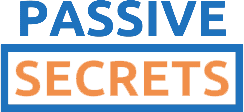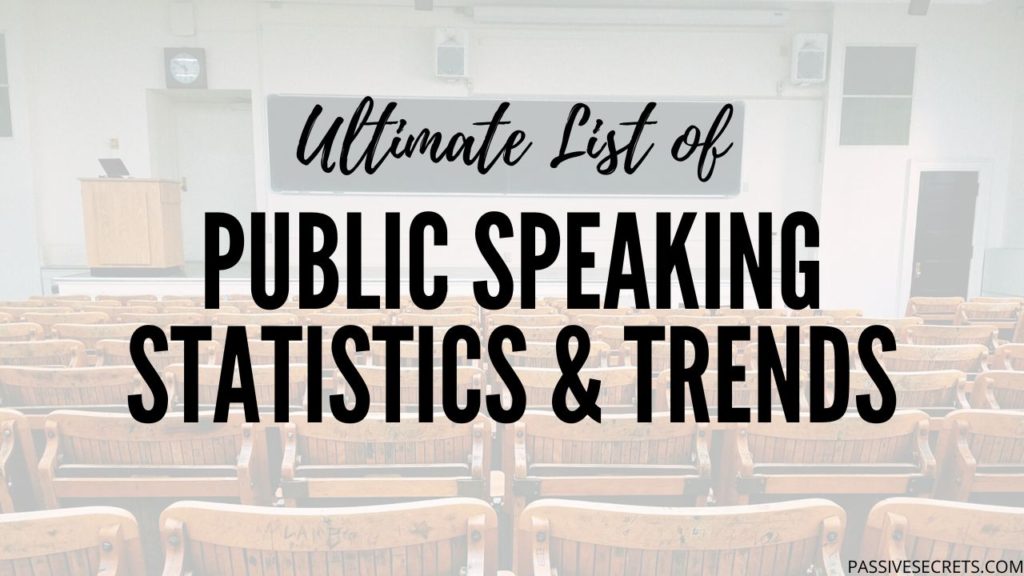
Imagine standing before a crowd to give your speech, but your hands suddenly become sweaty, and you can’t even get a word out.
Or maybe you start feeling an uncomfortable urge in your stomach. This feeling goes beyond the general nervousness you feel when doing something new.
If you feel like this in front of a crowd, you are not alone.
The fear of public speaking, also known as glossophobia, is very common worldwide. It is a subtype of social anxiety disorder.
In this article, I will share the latest statistics about glossophobia so you feel less alone and more enlightened.
I also share the latest public speaking statistics and trends to help you prepare for your next presentation.
Key Highlights: Interesting Stats on Public Speaking
- Research indicates that communication in public speaking is 55% non-verbal, 38% vocal, and 7% words, emphasizing the importance of composure.
- Creating a compelling story is cited as the most challenging part of public speaking preparation by 46% of surveyed respondents, highlighting the need for engaging storytelling.
- The fear of public speaking ranks among the top three fears in the US, highlighting its widespread impact on individuals.
- Up to 92% of surveyed respondents agree that excellent presentation skills are crucial to work success, highlighting the value of effective public speaking.
- The fear of public speaking is among the top 3 fears in the US, with death and financial problems being the no.1 & 2, respectively. Research has shown that 75% of the population suffers from glossophobia, indicating its widespread impact on individuals’ lives.
- In 2020, approximately 40 million individuals were diagnosed with glossophobia, shedding light on the prevalence of public speaking anxiety.
- Up to 92% of surveyed respondents agree that excellent presentation skills are crucial to work success, highlighting the value of effective public speaking.
- The fear of public speaking can impair wages by 10% and hinder promotion to higher positions by 15%, highlighting its potential impact on professional growth.
- Approximately 45% of people have either rejected a promotion or refrained from applying for a job due to glossophobia, underscoring its influence on career decisions.
- About 86% of people in low-income communities earning less than $50,000 a year report an intense fear of public speaking, indicating a correlation between income and glossophobia.
General Public Speaking Statistics
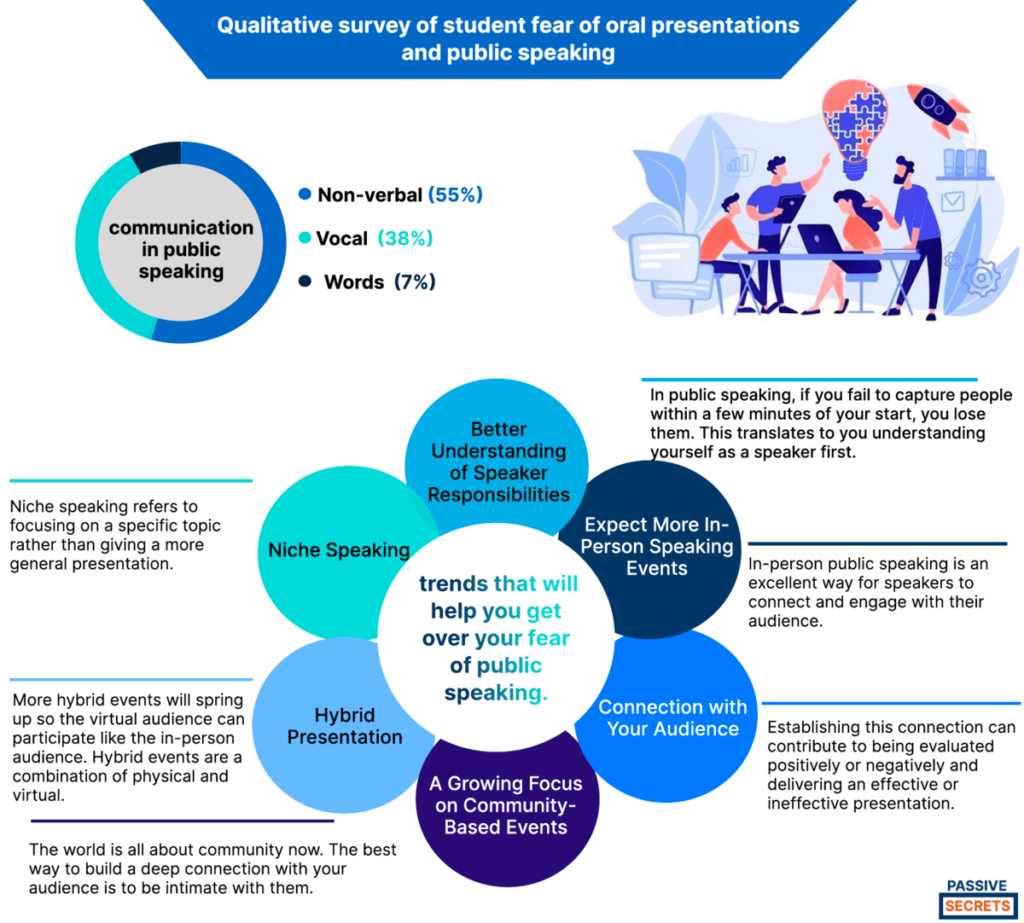
1. Research has shown that communication in public speaking is 55% non-verbal, 38% vocal, and 7% words. Hence, it is essential to pay attention to every aspect of your composure as a public speaker. (source)
2. Although compelling storytelling attracts the audience’s attention, 46% of surveyed respondents cite “creating a compelling story” as the most challenging part of preparation. “Designing a creative layout” comes in second with 45%, while “finding and using great visuals” comes in third place with 41%. (source)
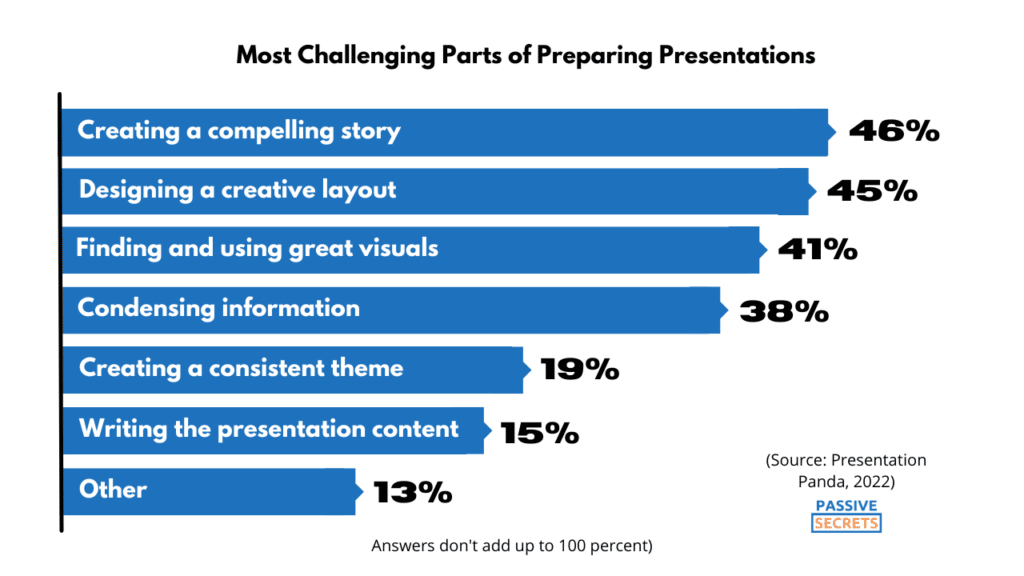
3. About 79% of people believe most presentations are terrible and boring. This is usually caused by poor or no visuals, lengthy bullet points, and failure to engage the audience. (source)
4. A glance test carried out in 2022 found that you have at most 3 seconds to capture your audience’s attention for each slide you present. (source)
5. Research has shown that the fear of public speaking is among the top 3 fears in the US, with death and financial problems being the no.1 & 2, respectively. (source).
6. Regarding public speaking, friendliness, assertiveness, and appearance matter greatly. This is because many people get their impressions based on these three things. (source)
7. About 91% of presenters feel more confident when presenting with a well-designed slide deck. (source)
8. Up to 92% of surveyed respondents agree that excellent presentation skills are crucial to work success. (source)
9. The most used software for public speaking and making presentations is Microsoft PowerPoint. 89% of public speakers and people who make presentations say the software is their primary go-to when presenting. (source)
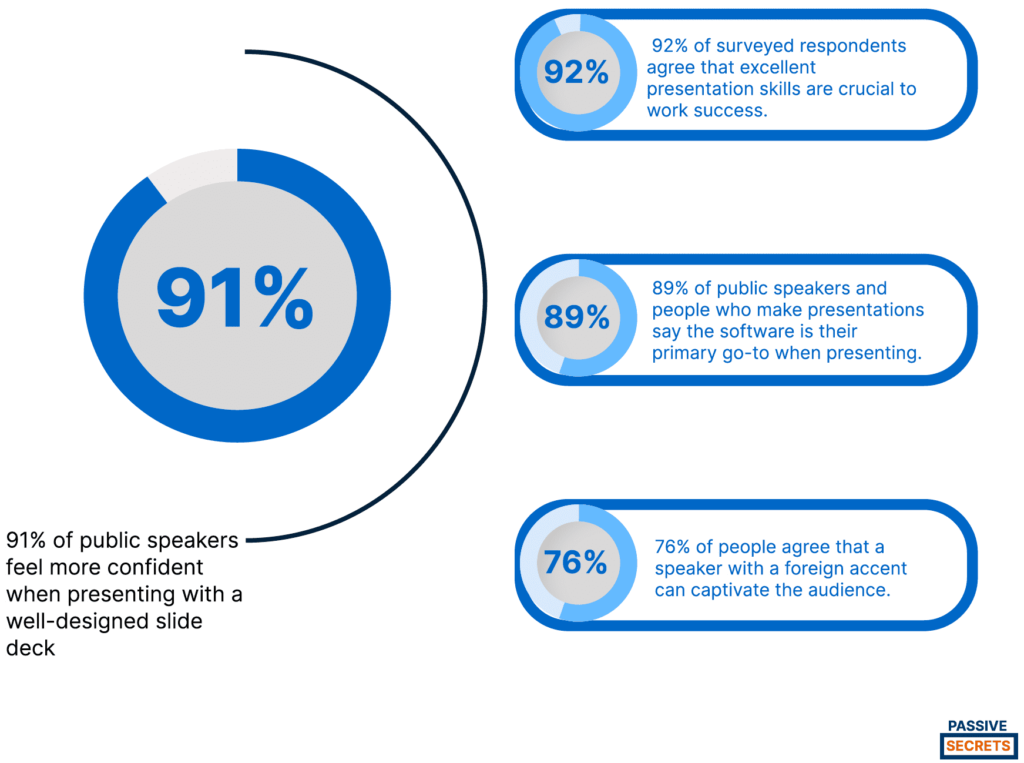
10. Individuals tend to face both internal and external fears when it comes to public speaking. (source)
The internal fears are usually the individual’s personal feelings and their perception about how their delivery would be. External fears are usually caused by the individual being too focused on their audience.
11. The National Speakers Association (NSA) has about 2,500 to 5,000 members. (source)
12. In a survey, 76% of people agree that a speaker with a foreign accent can captivate the audience. (source)
13. 60% of people say they will not respect a poorly dressed speaker. This shows that your appearance affects how your audience will receive you and engage with what you say. (source)
14. According to Guinness World Records (GWR), Donald Trump is the highest-paid public speaker for a single event, with $1.5 million for every speech. However, he is not the highest-paid or richest public speaker. Tony Blair still holds that position. This is because Donald Trump doesn’t get as many public speaking events as Tony Blair or other top public speakers. (source)
15. As a public speaker, it takes 27 seconds to make a good first impression. (source)

First impressions matter a lot because people prefer to listen to speakers who are confident and smart-looking.
Fear of Public Speaking (Glossophobia) Statistics
16. In 2020, about 40 million individuals were diagnosed with glossophobia. (source)
Glossophobia is an anxiety disorder whereby one is faced with extreme fear when it comes to talking in front of a large crowd of people.
17. 86% of people who live in low-income communities and earn less than $50.000 a year reportedly have an intense fear of speaking in public. This fear comes from a deep insecurity. (source)
18. It was estimated that individuals spend an average of 3-4 weeks in a year worrying about speaking in front of a crowd. (source)
19. The significant causes of public speaking anxiety (PSA) in students are fear of low evaluation by teachers, fear of past failures, and fear of negative audience feedback. Other causes can include poor skills development, genetics, and even embarrassment. (source)
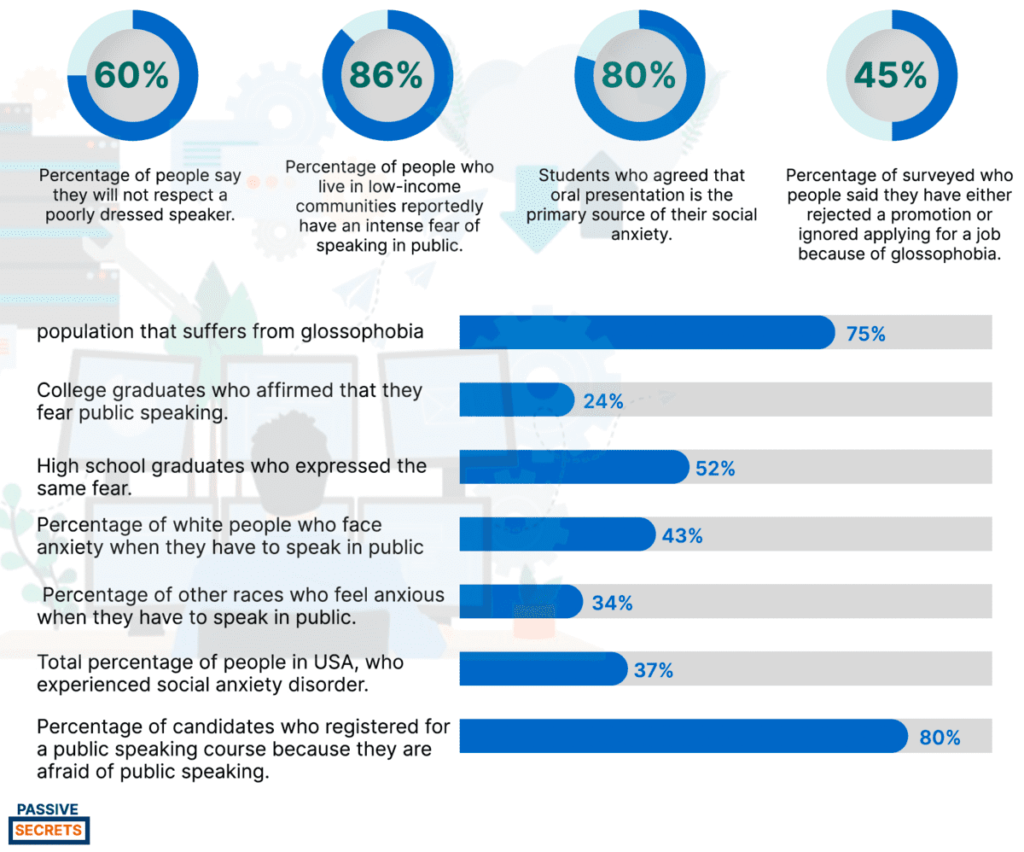
20. People start to notice they have social anxiety disorder between the ages of 8 – 15 years. (source)
21. 44% of women and 37% of men feel very anxious when talking to a large crowd. This means that women are more likely than men to be crumbled by anxiety in public speaking. (source)
22. People with severe public speaking anxiety (PSA) often experience physical effects like sweaty palms, very fast heartbeats, and quivering speech. (source)
23. A recent survey discovered that 64% of U.S. undergraduates report a fear of public speaking. (source)
24. About 80% of UK students agreed that oral presentation is the primary source of their social anxiety. (source)
25. About 74% of surveyed Gen-Zers say they fear public speaking. (source)
26. According to a survey in Finland, 1 out of every 3 students reports that public speaking is a severe problem for them. (source)
27. Almost half (45%) of surveyed people say they have either rejected a promotion or ignored applying for a job because of glossophobia. (source)
28. 80% of candidates who registered for a public speaking course say they actively avoid situations that involve them speaking to the audience. (source)
29. A study conducted has shown that regarding the level of public speaking anxiety, 50% of participants recorded having high anxiety, 42% moderate anxiety, and 9% low anxiety. (source)
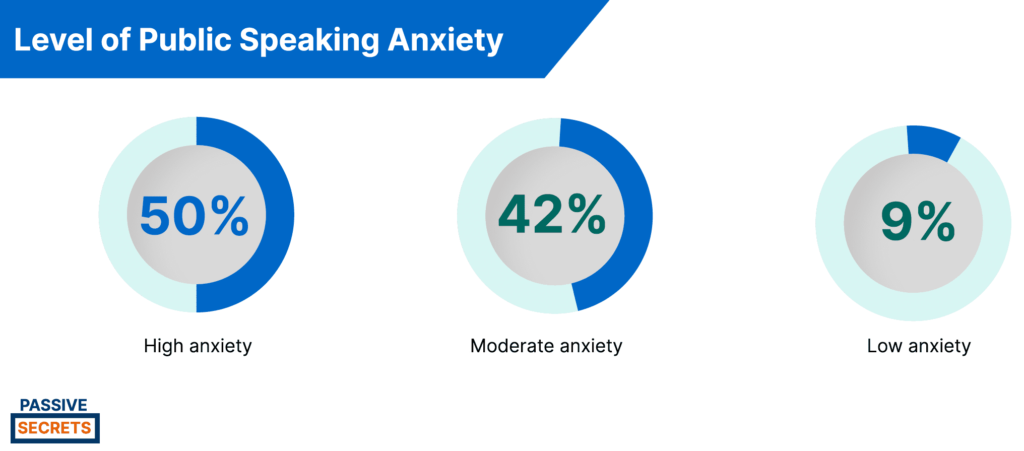
30. About 75% of the population suffers from glossophobia. Some people experience theirs as a slight nervousness, while others experience severe panic attacks. (source)
31. The fear of public speaking is so intense that it can impair your wages by 10% and your promotion to a higher position by 15%. (source)
32. 24% of college graduates affirmed that they fear public speaking. On the other hand, 52% of respondents with a high school diploma or less also felt that fear. (source)
33. 24% of surveyed college students expressed their deep fear of public speaking. Additionally, 52% of high school graduates expressed the same fear. This shows that educational level affects people’s phobia of public speaking. (source)
34. Research has shown that 43% of white people face anxiety when they have to speak in public, and 34% of other races feel anxious when they have to speak in public. (source)
35. In the USA, a total of 7.9% of people, both male and female, experienced social anxiety disorder. (source)
Latest Public Speaking Trends For 2024 and Beyond
The art of public speaking has changed over the years and perhaps will experience more significant changes in the future.
The evolution started with speakers performing magic with their words alone and then came the advent of PowerPoint.
The introduction of visuals to public speaking encouraged people to listen more.
Presently, public speaking can be done virtually. This is known as virtual speaking, and it is spreading like a virus.
Hosts and speakers hold virtual speaking events on Google Meet, Zoom, Skype, and other forms of video conferencing.
Furthermore, the average audience attention span is eight to ten minutes. This implies that as a speaker, you need to do something different every eight to ten minutes to wake up your audience and avoid them sleeping on you.
Due to people’s schedules, speaking times are now shorter. Speakers are allocated 10 minutes or, at most, 30 minutes to share a talk.
This change and other not-so-blown changes have created trends and practices that speakers need to take heed of while speaking.
Let’s take a closer look at these latest trends in the world of public speaking. These trends will also help you get over your fear of public speaking.
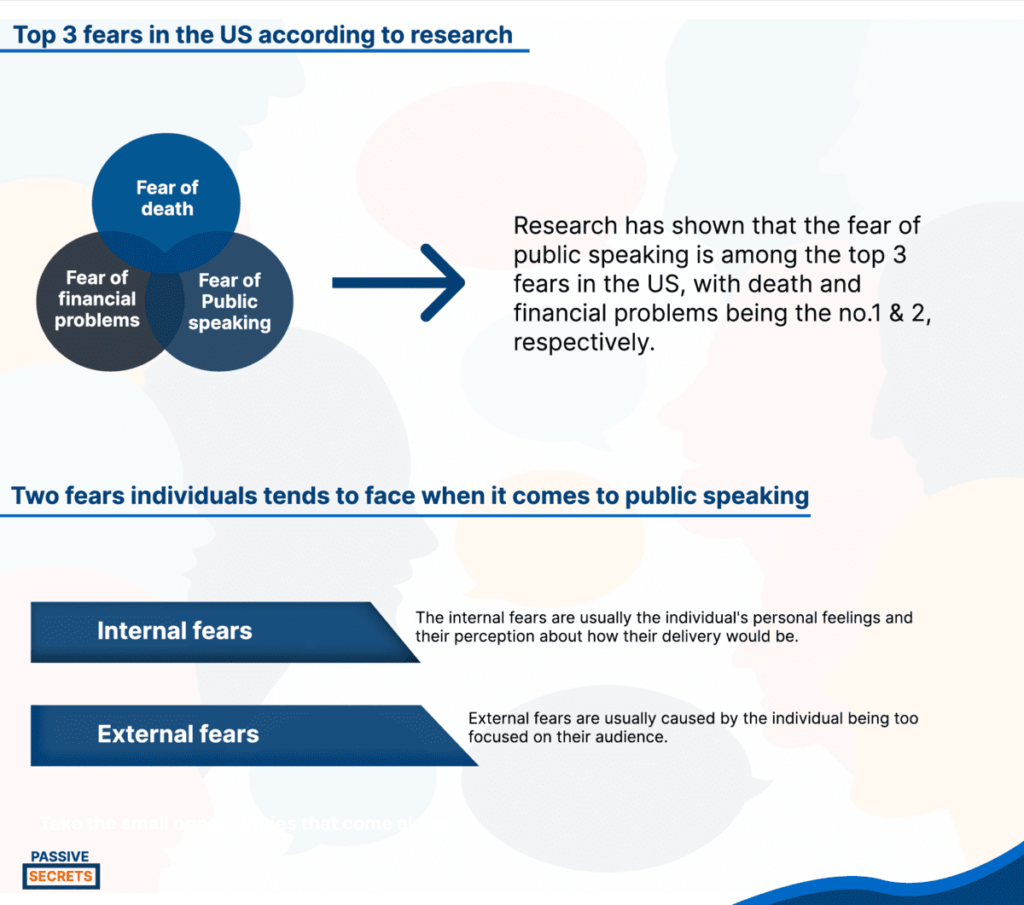
1. Better Understanding of Speaker Responsibilities
In public speaking, if you fail to capture people within a few minutes of your start, you lose them. This translates to you understanding yourself as a speaker first.
Remember that you are responsible for your pre-speech, research, writing, visuals, and delivery.
Also, be prepared to answer questions thrown at you by the audience and be ready for interaction.
In your responsibility as a speaker, be mentally prepared for whatever comes. Your audience will know if you’re thrown off balance during the speech.
Your response can encourage them to listen more or back out.
We live in a virtual world, and preparation for a live speech differs from a virtual speech.
Did you know that 67.3% of all speeches are delivered on a virtual stage? Therefore, set your virtual speaking stage, which includes lighting, a microphone, background, and the speech itself.
2. Expect More In-Person Speaking Events
Although virtual speaking events had their fair share of fame thanks to the pandemic, in-person events are rapidly taking back their momentum.
In-person public speaking is an excellent way for speakers to connect and engage with their audience. They can interact with their audience without any possible distractions.
While it slowly started to pick up in 2022 and 2023, in-person events will increase rapidly in 2024. Speakers now have the opportunity to shake hands with their audience and engage in some chit-chat.
3. Connection with Your Audience
Gone are the days when all you do is give your long speech and expect your audience to give you a standing ovation without connecting with them.
As time advances, people are now getting increasingly distracted. You might be left with a sleeping or completely distracted audience if you are not careful.
Speakers know this and are now consciously trying to engage their audience actively.
If you lose your audience, you have no speech or talk.
Establishing this connection can contribute to being evaluated positively or negatively and delivering an effective or ineffective presentation.
An audience connected with you aren’t active listeners and participants.
In a live speech, you connect with your audience by looking at them a bit longer. This means you make eye contact with them.
Avoiding eye contact makes you look like you lack confidence.
A common piece of advice for speakers is to “look to all parts of the room and focus on some people.” Are you aware that your audience can get neglected?
Yes, they can when you glance over them rather than at them.
Be careful not to overdo this; looking people in the eye too long becomes creepy.
In a live audience, smile, infuse humor into your speech, know your audience, and refer to what they know.
When you refer to what people know, they don’t feel left out; they get closer and yearn to hear more.
If possible, walk towards your audience or walk around. However, this should not be mistaken for moving around the room, as this could cause distraction.
However, in a virtual world, your energy needs to be felt since your audience is not live, and you can’t walk up to them or look them in the eye.
3. A Growing Focus on Community-Based Events
The world is all about community now. The best way to build a deep connection with your audience is to be intimate with them.
You cannot speak to everyone at once, but you can speak to your niche audience at once.
Gone are the days when speaking to a huge crowd was an achievement. Speakers wanted to reach an audience of 2000+ people.
Now, that number has reduced as more speakers prefer building a more engaged community.
Keeping an audience of 250+ people engaged is easier than an audience of 1000+.
Are there still speaking events with a vast crowd? Yes, but they aren’t as common as they used to be.
For speakers, an intimate audience is an opportunity to make an impact. And get more positive feedback.
4. Continued Use of Videos
This is an evergreen trend as video content still remains one of the most consumable content.
Videos are an excellent way to grab your audience’s attention.
People are no longer interested in just texts or plain graphs; they want colorful images on the screen. As a public speaker, capitalize on this and imbibe them in your image.
People easily remember when there are videos and clips to back up any spoken message.
In using videos, ensure you use short and punchy video clips to make your mark on your audience.
A video has less than a minute to create an impression. Hence, speakers focus on using short videos.
The relevance of your video counts, too. If your audience deems your video appropriate, short, and punchy, you’ve gotten their attention. Let the video carefully iterate and illustrate your points.
However, a video shouldn’t be 70% of your entire speech. Learn when to pause and play a video and speak to your audience using your mouth.
5. Workshop Presentations Will Become Common for More Participation
Audience participation in a public speaking event is critical. It doesn’t matter whether it is virtual or in-person.
Hence, more speaking events will adopt a workshop style.
Using this style is more interactive because the audience gets to participate fully and connect.
This means that speakers will be ditching the large stage to be in the midst of the audience and showing practical examples.
The audience can see you well, interact, and build a positive relationship with you.
6. Hybrid Presentation
Yes, in-person events are back. But that doesn’t mean virtual speaking events will die off. The pandemic showed us the possibility of virtual meetings and events.
Speakers can have an audience from all over the world. Both physical and virtual events are beneficial for speakers.
So what does it mean? It means that speakers can enjoy the best of both sides.
More hybrid events will spring up so the virtual audience can participate like the in-person audience. Hybrid events are a combination of physical and virtual.
Most speakers make the mistake of throwing their full weight behind the live audience, creating a “left out” feeling for the virtual audience.
When the “left out” feeling encroaches and takes over them, they wouldn’t want to join again because they would prefer to be at the live show.
The best way out of this is to manage the two audiences. You can request from your organizer a means of seeing the virtual audience.
Seeing the live audience equates to giving them a feel of the room, the audience, and you, the speaker. They can also see the screen, giving them a focal range.
Are you aware that at certain times, things that seem funny to a live audience may not be to a virtual audience? This action calls for consciousness and awareness of the needs of both parties.
Review your presentation thoroughly and find where to infuse both parties; it mustn’t be together. Make references to them and call them out during your speech.
7. Niche Speaking
Niche speaking refers to focusing on a specific topic rather than giving a more general presentation.
This trend is most likely to be pushed by the growing popularity of personalized content and the need for authenticity and connection.
Niche speaking helps speakers connect more with their audience by focusing on a topic that they are genuinely passionate about.
It is a public speaking approach that is tailored to a particular audience.
Niche speaking can be more personal and engaging, allowing the speaker to connect with the audience on a deeper level.
This can be very effective, especially when the audience shares the same interest as the speaker.
8. Personal Branding
Personal branding is another public speaking trend that is predicted to grow in popularity in the coming years. It involves creating and communicating a unique and authentic identity, both online and offline.
This can be especially effective in public speaking, as it allows the speaker to connect with the audience on a more personal level.
Personal branding can also help the speaker stand out from the crowd and build a strong reputation.
In terms of public speaking, personal branding will likely become more critical as technology advances, and it becomes easier to connect with an audience on a more personal level.
Different social media platforms would allow speakers to share their personal brand with a broader audience and build a following.
This can lead to more speaking opportunities and a more substantial reputation as a thought leader in a specific niche.
Personal branding can also be used to create a sense of authenticity and trust with an audience, which can be especially important in the public speaking context.
Frequently Asked Questions
1. What Jobs Require Public Speaking?
Jobs that require public speaking include lawyers, parent representation, teachers, spokesmen/women, spokespersons, politicians, and others.
2. Why is Public Speaking Important?
Your speech can either make or mar anyone. As a speaker, your words are like an arrow. They shoot people either for positive or negative reasons. People stay informed through a speaker.
3. What are Some Fears of Public Speaking?
There’s fear of doubt, crowd and their reaction, forgetting, audience, nervousness, and fear of the unexpected.
4. Is Public Speaking More Feared Than Death?
Yes, a lot of people’s phobia of public speaking is justified. Some people would rather die than speak in public. Statistics show that about 73% of the world’s population suffers from the fear of public speaking (glossophobia).
5. What are the Symptoms of Glossophobia?
The synonyms of glossophobia include rapid heartbeat, shortness of breath or hyperventilating, trembling, vomiting, muscle tension, sweating, nausea, and dizziness.
6. How Many People are Afraid of Public Speaking?
The fear of public speaking affects around 75% of the population. In another survey, 40 million people in the U.S. aged 18 or older suffer from various forms of public speaking anxiety. Moreover, glossophobia, also known as the fear of public speaking, is considered the most common phobia, impacting approximately 75% of individuals.
Conclusion
It takes a lot of courage to stand before an audience and give a speech. No wonder people fear public speaking the most.
With these latest public speaking statistics and trends, you know what to expect when speaking before an audience and how to handle your glossophobia.
Your audience will appreciate you if you end your speech on time.
Plus, having good public speaking and presentation skills helps build your self-confidence.
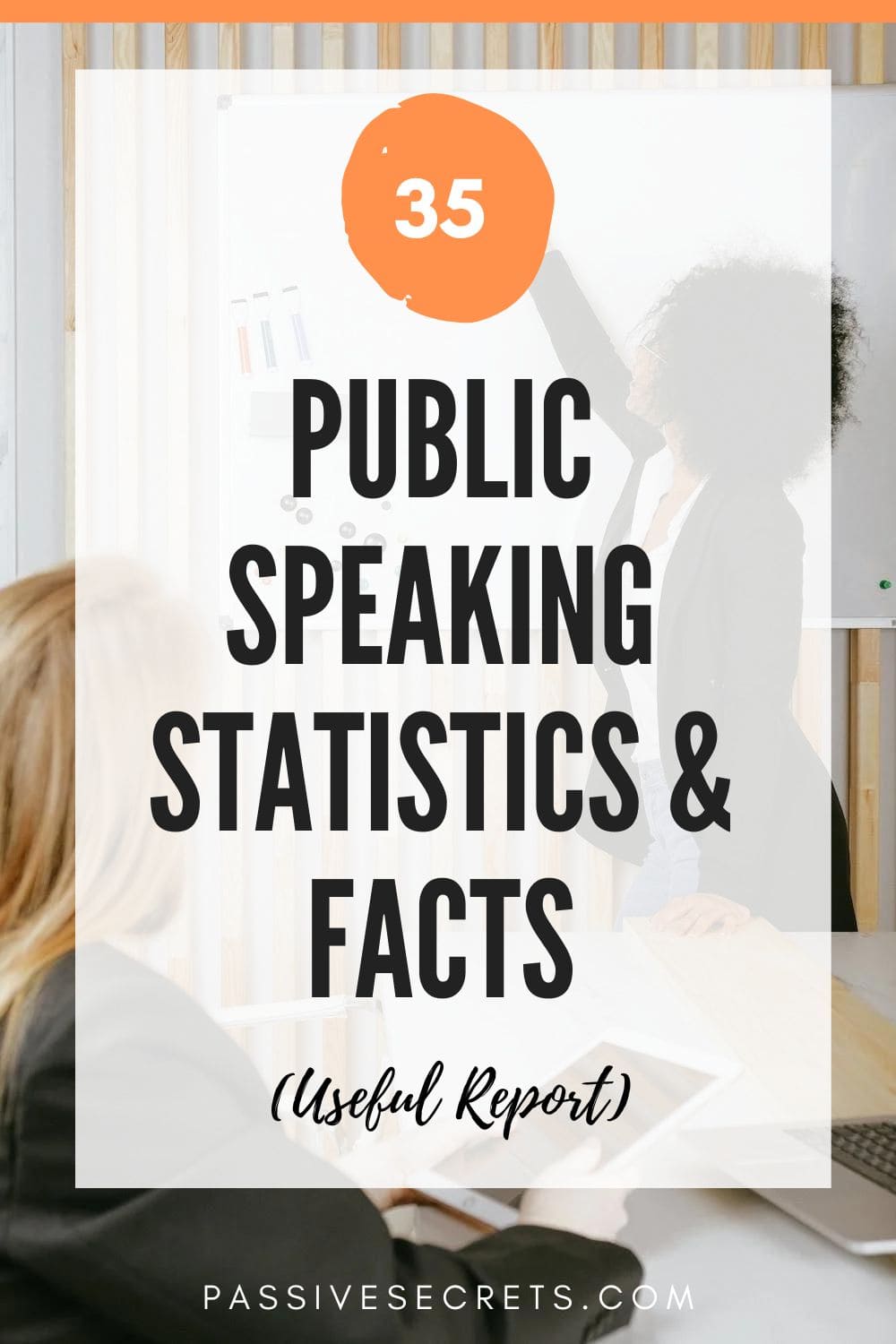
Related Posts:
- 73 Revealing Workplace Distraction Statistics [2024]
- 40+ Top Workplace Conflict Statistics You Should Know In 2024
- 68 Performance Management Statistics & Trends in 2024 (Full Report)
- 25+ Best Emotional Intelligence Statistics to Know in 2024
- 71 Important Workplace Communication Statistics To Know in 2024
- 55 Teamwork & Workplace Collaboration Statistics To Boost Your Employee Performance
- 20 Crucial Body Language Statistics To Know In 2024
- 47+ Important 4-day Work Week Statistics [2024]
- 45+ Important Communication Skills Statistics & Trends For 2024
- 50+ Latest Life Coaching Statistics and Trends in 2024
- 36 Interesting Social Worker Burnout Statistics for 2024
- 110+ Important Social Media Advertising Statistics & Trends To Help You in 2024
- 41+ Best Copywriting Statistics & Trends to Help You in 2024 And Beyond
- 45+ Useful Omnichannel Marketing Statistics, Data, Trends, & Strategies to Boost Sales Results
- 100+ Top Digital Marketing Vs. Traditional Marketing Statistics To Know in 2024
- B2B Lead Generation Statistics, Facts, Benchmarks All Marketers Need to Know in 2024
- Holiday Spending Statistics: Valentine’s Day, Easter, Thanksgiving, & Christmas
- Spotify Statistics: Latest Report on The Music Streaming Platform
- Amazon Book Sales Statistics: Intriguing Numbers and Facts
- 60+ Helpful Change Management Statistics & Facts To Know
- 50+ Useful Video Game Addiction Statistics, Facts, & Huge Trends
- Internet Dangers Statistics: A Look At The Internet’s Dark Side
- 50+ Vital Internet Safety Statistics & Facts You Must Know
- 70 Exciting Love Statistics And Facts (True Love, Intimacy, Marriage, Dating & Relationships)
- 65+ Impressive Chess Statistics and Facts To Know in 2024
- 40+ Useful Procrastination Statistics To Help You In 2024
- 55+ Useful Black Consumer Spending Statistics (2024 Report)
- 54 Incredible Goal-Setting Statistics To Help You In 2024
- 50+ Call Center Statistics And Big Trends [Latest 2024 Report]
